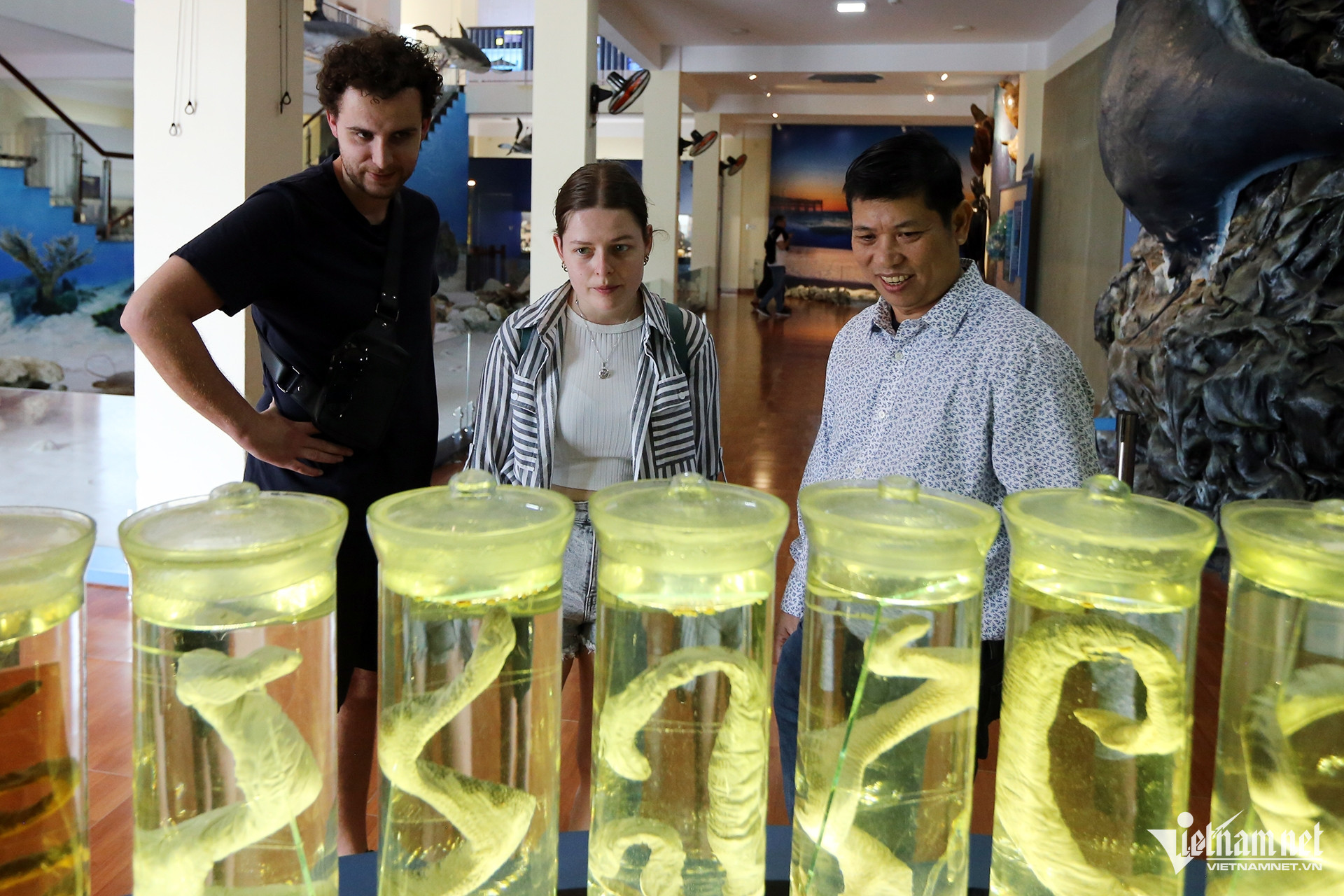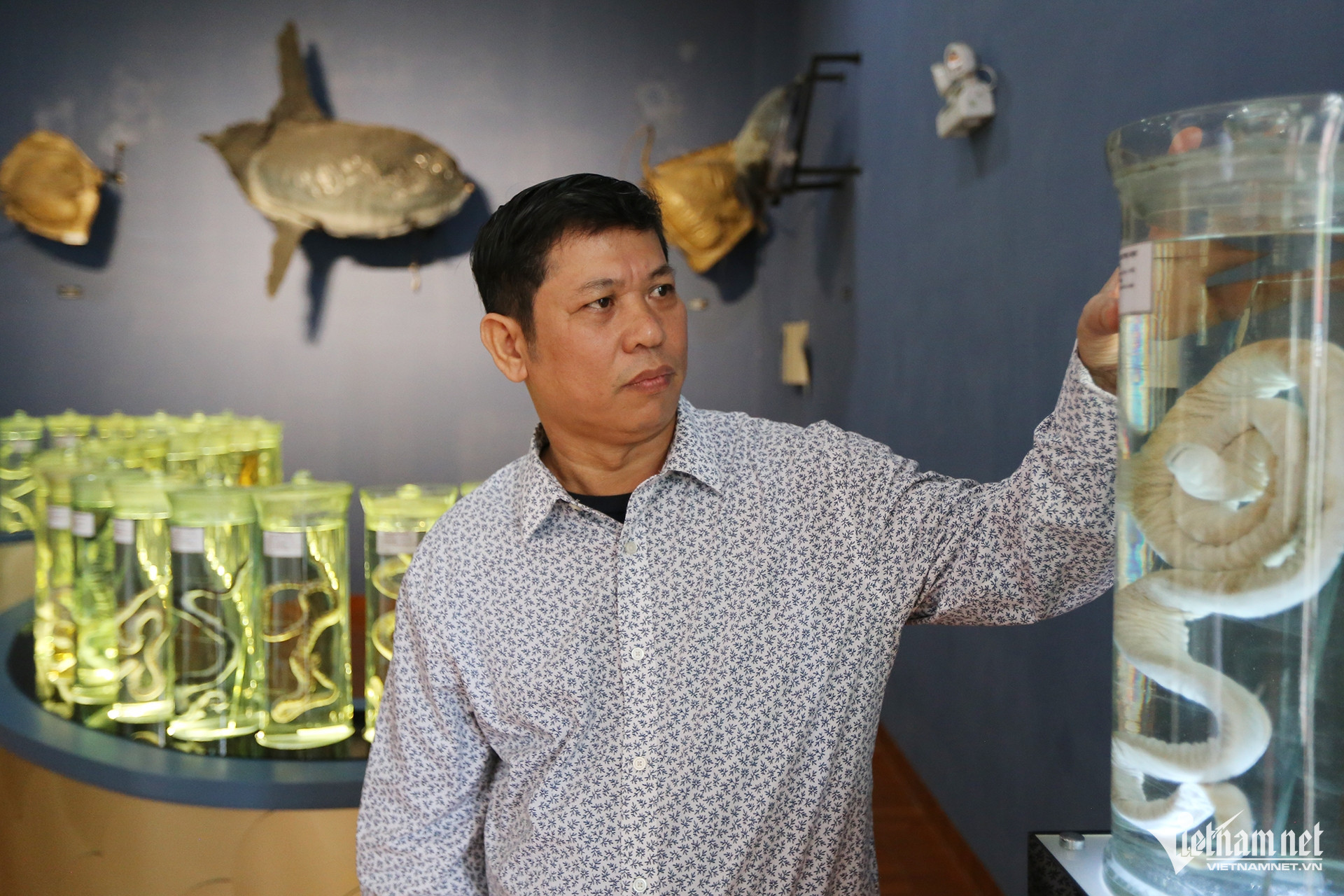At the Institute of Oceanography in Nha Trang, Khanh Hoa, researcher Cao Van Nguyen (51 years old) has spent decades meticulously collecting and preserving all 26 species of sea snakes found in Vietnam.
His work has created a vital genetic resource for marine biodiversity conservation and scientific research.
A rare collection of Vietnam’s sea snake species

As the Lunar New Year holiday approaches, the Institute of Oceanography is bustling with visitors. In one of its exhibition halls, Cao Van Nguyen carefully inspects formalin-preserved sea snake specimens, arranged according to species. When approached by visitors, he enthusiastically shares the history and characteristics of each specimen.
Leading VietNamNet reporters through the collection, Nguyen introduces himself as a graduate of Nha Trang Fisheries University (now Nha Trang University). Since joining the Institute of Oceanography in 1998, he has specialized in studying sea snakes and marine turtles.
His passion for marine life led him to collaborate with international research teams from Denmark, the United States, and Australia in 2001.

Since then, Nguyen and his colleagues have traveled extensively to collect, study, and preserve sea snake specimens, ensuring the long-term conservation of their genetic material.
Nguyen reflects on the many expeditions he has undertaken to build the comprehensive collection of sea snake specimens on display today.
"Timing is crucial in specimen preservation," he explains. "When a sea snake is collected - whether dead or alive - it must be processed immediately to prevent decomposition."
Each specimen is carefully treated with formalin to preserve its structure. This meticulous process requires a deep understanding of the snake’s anatomy to prevent skin damage and maintain its lifelike appearance.
Initially, the strong chemical smell of formalin was overwhelming for Nguyen, but over time, with proper protective gear, he adapted to the work.
Sea snake venom in medical research

With over 20 years of experience, Nguyen can effortlessly identify, classify, and explain the unique traits of each sea snake species. His research has also led to fascinating discoveries about these marine reptiles.
Globally, there are 62 known sea snake species, primarily found in tropical and subtropical waters from the Indian Ocean to the Pacific. Of these, 26 species inhabit Vietnam’s coastal waters - all of which are preserved at the Institute of Oceanography.
Some species are particularly rare and unique. For example, the yellow-lipped sea krait (Laticauda colubrina) is the only egg-laying sea snake species. It is commonly found in Nha Trang Bay’s coral reefs, where it carefully guards its eggs until they hatch.
Newborn sea snakes measure about 20 cm in length and immediately begin hunting on their own. As adults, they can grow up to 1.5 meters, with some individuals weighing nearly 1 kg. Despite their venomous nature, sea snakes are not aggressive toward humans.
Among all species, the hook-nosed sea snake (Enhydrina schistosa) is considered the most venomous. Interestingly, its venom has medical applications - its antivenom can be used to treat bites from other venomous snakes. This therapy remains effective even 24 to 36 hours after a snakebite, making it a crucial resource in medical treatments.
Preserving marine biodiversity for future generations

The Institute of Oceanography is committed to creating a comprehensive reference collection to support scientists, students, and marine life enthusiasts.
"By studying, classifying, and documenting Vietnam’s sea snake species, we aim to raise public awareness about the importance of marine biodiversity conservation," Nguyen emphasizes.
Beyond preservation, he is also actively researching:
The biological characteristics and ecological roles of sea snakes.
How climate change is affecting their distribution and reproductive patterns.
Nguyen is also the lead author of the book "Vietnam’s Sea Snakes", published in 2015 in both English and Vietnamese, providing valuable insights for researchers and the general public.
His work continues to shed light on these fascinating yet often misunderstood marine reptiles, ensuring their conservation for future generations.
Xuan Ngoc